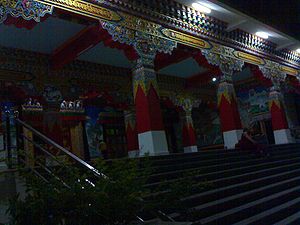
Mundgod
Encyclopedia
Mundgod is a panchayat town in Uttara Kannada district in the India
n state
of Karnataka
. It lies en route to Hubli from Sirsi. It is a Main road town.
 Mundgod is the repository of Tibetan life and culture. It showcases the life style and ambitions of the Tibetan
Mundgod is the repository of Tibetan life and culture. It showcases the life style and ambitions of the Tibetan
refugees and reflects the gradual transformation of a traditional society into modernity. It has rightfully earned the name Mini Tibet.
Reference : www.binoygupta.com/travel_india/travel-india-mundgod-mini-tibet-54/
It is about 6 km from Mundgod and 7 km from Attiveri Bird Sanctuary.
Attiveri Bird Sanctuary is around 15 km from Mundgod in Uttara Kannada District of Karnataka.
from Hubli-Dharwad it is 43 km away.
Spread over an area of about 2.23 km2, the sanctuary is located in and around the Attiveri reservoir. The part of the sanctuary surrounding the reservoir has riverine and deciduous forests.
Birds that inhabit this area include Indian shag
, cattle egret
, little cormorant
, spoonbill
, pied kingfisher
, white ibis
, white-breasted kingfisher, Indian Grey Hornbill
and common swallow
. The agricultural fields surrounding the sanctuary attract a variety of aquatic creatures.
Best time to visit the sanctuary is between November and March.
, Mundgod had a population of 16,171. Males constitute 51% of the population and females 49%. Mundgod has an average literacy rate of 67%, higher than the national average of 59.5%: male literacy is 73%, and female literacy is 62%. In Mundgod, 15% of the population is under 6 years of age.
With the help of the Government of India, the Tibetan administration, in the early 1960s, proposed to start a number of settlements for the Tibetan refugees. Tibetan settlement in Mundgod is one of them. Government of India in consultation with the state Government of Karnataka agreed to provide 4,000 acres (16 km²) of mostly forestland near Taluk village in North Kanara district 1900 feet (580 m) above sea level. The settlers were provided tents and bamboo huts for temporary shelter in the beginning. All the work in the settlement was done on co-operative basis and settlers were provided free dry ration. Doeguling Tibetan Settlement in Mundgod was established in 1966.
India
India , officially the Republic of India , is a country in South Asia. It is the seventh-largest country by geographical area, the second-most populous country with over 1.2 billion people, and the most populous democracy in the world...
n state
States and territories of India
India is a federal union of states comprising twenty-eight states and seven union territories. The states and territories are further subdivided into districts and so on.-List of states and territories:...
of Karnataka
Karnataka
Karnataka , the land of the Kannadigas, is a state in South West India. It was created on 1 November 1956, with the passing of the States Reorganisation Act and this day is annually celebrated as Karnataka Rajyotsava...
. It lies en route to Hubli from Sirsi. It is a Main road town.
Tourist attractions of Mundgod region
- Tibetan colony Mundgod

refugees and reflects the gradual transformation of a traditional society into modernity. It has rightfully earned the name Mini Tibet.
Reference : www.binoygupta.com/travel_india/travel-india-mundgod-mini-tibet-54/
- Bachanaki Dam
It is about 6 km from Mundgod and 7 km from Attiveri Bird Sanctuary.
- Attiveri Bird Sanctuary
Attiveri Bird Sanctuary is around 15 km from Mundgod in Uttara Kannada District of Karnataka.
from Hubli-Dharwad it is 43 km away.
Spread over an area of about 2.23 km2, the sanctuary is located in and around the Attiveri reservoir. The part of the sanctuary surrounding the reservoir has riverine and deciduous forests.
Birds that inhabit this area include Indian shag
Indian Cormorant
The Indian Cormorant or Indian Shag is a member of the cormorant family. It is found mainly along the inland waters of the Indian Subcontinent but extending west to Sind and east to Thailand and Cambodia...
, cattle egret
Cattle Egret
The Cattle Egret is a cosmopolitan species of heron found in the tropics, subtropics and warm temperate zones. It is the only member of the monotypic genus Bubulcus, although some authorities regard its two subspecies as full species, the Western Cattle Egret and the Eastern Cattle Egret...
, little cormorant
Little Cormorant
The Little Cormorant is a member of the Cormorant family of seabirds: Aptly named, the Little Cormorant is small in comparison with other cormorants, only 55 cm in length with an average mass of 442.5 g...
, spoonbill
Spoonbill
Spoonbills are a group of large, long-legged wading birds in the family Threskiornithidae, which also includes the Ibises.All have large, flat, spatulate bills and feed by wading through shallow water, sweeping the partly opened bill from side to side...
, pied kingfisher
Pied Kingfisher
The Pied Kingfisher is a water kingfisher and is found widely distributed across Africa and Asia. Their black and white plumage, crest and the habit of hovering over clear lakes and rivers before diving for fish makes it distinctive. Males have a double band across the breast while females have a...
, white ibis
White Ibis
There are three species of bird named White Ibis.* American White Ibis, Eudocimus albus* Australian White Ibis, Threskiornis molucca* Asiatic White Ibis is an alternative name for the Black-headed Ibis, Threskiornis melanocephala...
, white-breasted kingfisher, Indian Grey Hornbill
Indian Grey Hornbill
The Indian Grey Hornbill is a common hornbill found on the Indian subcontinent. It is mostly arboreal and is commonly sighted in pairs. They have grey feathers all over the body with a light grey or dull white belly. The horn is black or dark grey with a casque extending up to the point of...
and common swallow
Swallow
The swallows and martins are a group of passerine birds in the family Hirundinidae which are characterised by their adaptation to aerial feeding...
. The agricultural fields surrounding the sanctuary attract a variety of aquatic creatures.
Best time to visit the sanctuary is between November and March.
Geography
Mundgod is located at 14.97°N 75.03°E. It has an average elevation of 567 metres (1860 feet).Demographics
India censusCensus
A census is the procedure of systematically acquiring and recording information about the members of a given population. It is a regularly occurring and official count of a particular population. The term is used mostly in connection with national population and housing censuses; other common...
, Mundgod had a population of 16,171. Males constitute 51% of the population and females 49%. Mundgod has an average literacy rate of 67%, higher than the national average of 59.5%: male literacy is 73%, and female literacy is 62%. In Mundgod, 15% of the population is under 6 years of age.
With the help of the Government of India, the Tibetan administration, in the early 1960s, proposed to start a number of settlements for the Tibetan refugees. Tibetan settlement in Mundgod is one of them. Government of India in consultation with the state Government of Karnataka agreed to provide 4,000 acres (16 km²) of mostly forestland near Taluk village in North Kanara district 1900 feet (580 m) above sea level. The settlers were provided tents and bamboo huts for temporary shelter in the beginning. All the work in the settlement was done on co-operative basis and settlers were provided free dry ration. Doeguling Tibetan Settlement in Mundgod was established in 1966.

